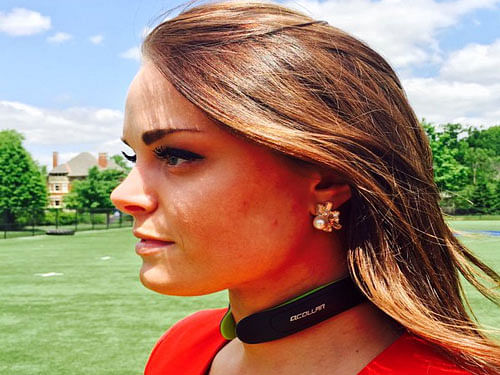
Wearing a specifically designed compression collar around the neck may prevent or reduce the devastating effects of head collisions in sports, two new studies have found.
The neck device, called a Q-Collar, is designed to press gently on the jugular vein to slow blood outflow increasing the brain's blood volume, according to researchers from Cincinnati Children's Hospital Medical Centre in the US.
The resulting effect of the increased blood volume helps the brain fit tighter within the skull cavity, reducing the energy absorbed by the brain during collisions, researchers said.
The analysis of neurophysiological and neuroanatomical data from the brain showed athletes in the non-collar wearing group had significant functional and structural changes to white matter regions of the brain but these changes were not evident in those who did wear the Q-Collar during play, they said.
"White matter of the brain essentially connects all the pathways including structure and function. Neuro-radiologists at Cincinnati Children's established a protocol for how the white matter in the brain is impacted after head collisions and what correlates to a brain injury," said Greg Myer from the hospital.
In the first study which involved hockey players, half the participants wore the collar for the hockey season and the other half did not. Each of the helmets for the athletes was outfitted with an accelerometre to measure every head impact.
Results from the imaging and electrophysiological testing indicated that athletes in the non-collar wearing group had a disruption of microstructure and functional performance of the brain. Athletes wearing the collar did not show a significant difference despite similar head impacts, researchers said.
In the second study, 42 football players participated. 21 athletes wore the collar during a competitive season. They were tested before play to make sure the lightweight, c-shaped neck collar fit properly, they said.
The other 21 players did not wear the collar.
All of the athletes' helmets were outfitted with an accelerometer - a computer chip - which tracked every hit sustained during the pre- and post- season.
Researchers used advanced magnetic resonance imaging (MRI) techniques, including diffusion tensor imaging (DTI), to determine the efficacy of the collar to prevent structural changes to the brain following a season of head impacts.
The results of the larger study showed similar protective effects of collar wear during the football season, researchers said.
"The results of the studies demonstrate a potential approach to protecting the brain from changes sustained within a competitive football and hockey season, as evidenced by brain imaging," said Myer.
The findings were published in the journals Frontiers in Neurology and British Journal of Sports Medicine.